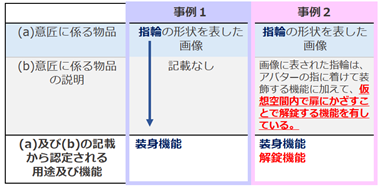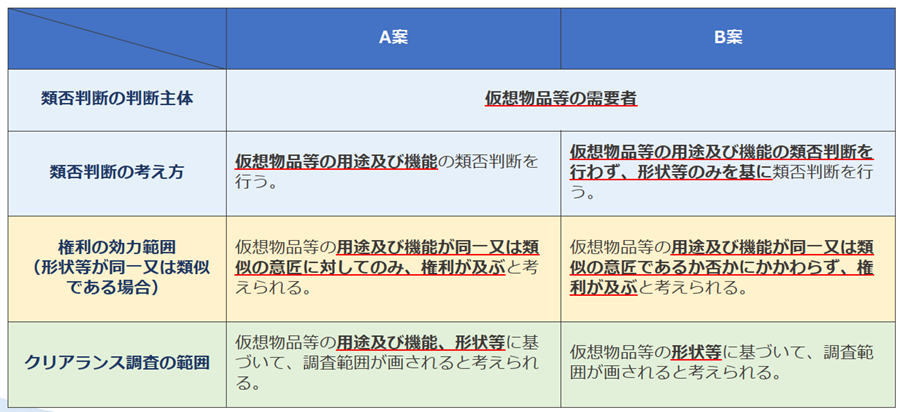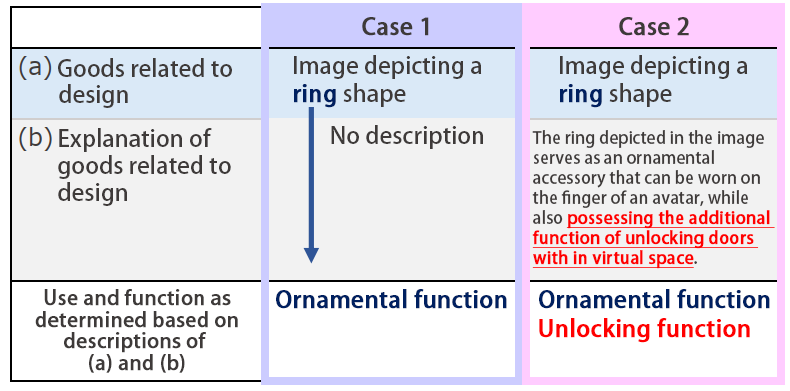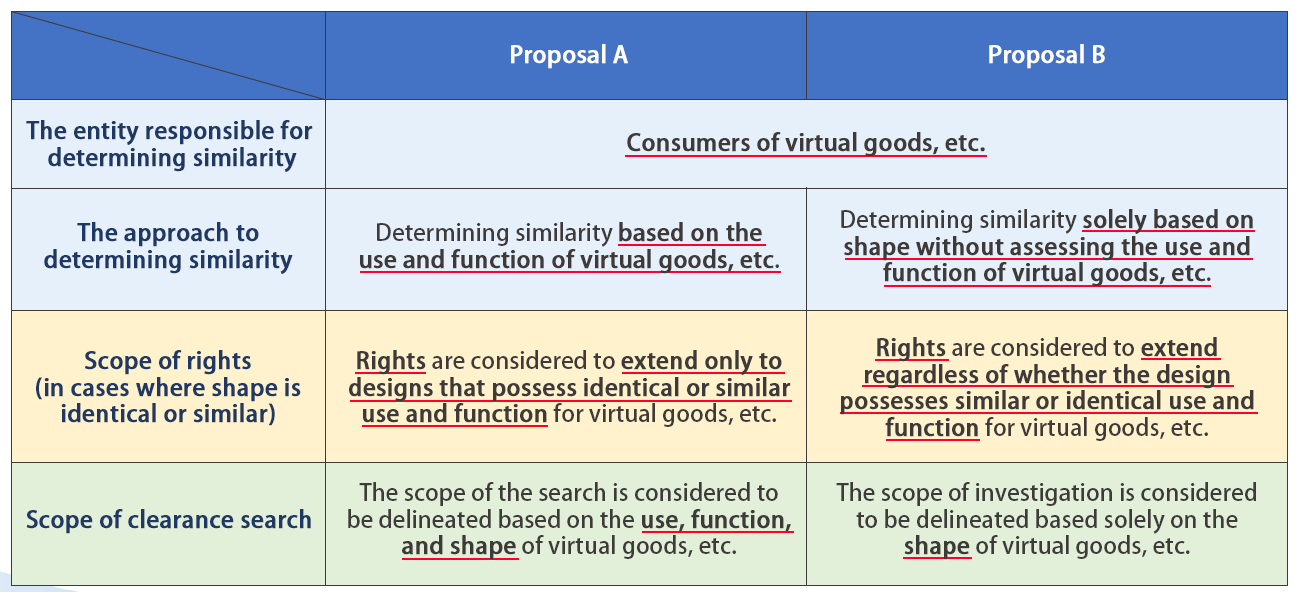目次
7月号【法務】ニュースレター

「意匠制度に関する検討課題について」第19回意匠制度小委員会
令和7年5月22日、特許庁にて第19回意匠制度小委員会が開催されました。当所のニュースレターにおいても、複数回、意匠制度小委員会の検討課題を取り上げましたが、重要な課題であるため、引き続き紹介します。検討課題から、意匠制度が、今後どのような方向性で改正を検討されているか知ることができます。今回は特に「仮想空間におけるデザインに関する意匠制度の在り方」から、意匠の類否判断における「用途・機能」についての課題を紹介します。(以下、「第19回意匠制度小委員会 配布資料1」(特許庁)から抜粋)
現行の画像意匠については、意匠の認定は「画像」としての用途および機能、形状等について行われます。しかしながら、仮想空間においては、仮想物品等は、現実空間で用いられる物品等と異なり、用途及び機能と形状等の関連性が希薄であり、機能の追加、削除も可能です。また、仮想空間においては物理法則の制約がないため、現実空間にはない物品等の機能を持たせることもできます。例えば、以下の事例2のように、「指輪」に「扉の解錠機能」を持たせることができます。

上記の事情から、以下のA案およびB案が検討されています。
A案:仮想物品等の用途及び機能の類否判断を行う
B案:仮想物品等の用途及び機能の類否判断を行わない
(形状等のみに基づいて類否判断を行う)

我が国の意匠制度と整合し、考慮すべき懸念(クリアランス調査の負担・萎縮効果:調査対象が膨大となる)が少ないことから、B案よりA案の方が適切であるとして対応案が示されていますが、今後、さらなる検討が行われるようです。
商標審査着手状況の公表と早期審査について
特許庁は、ウェブサイトに「商標審査着手状況(審査未着手案件)」のページを設けて、商標登録出願後、審査未着手の案件の着手見通し時期を公表しています。
当該ページは4ヶ月ごとに更新され、更新された月から3ヶ月先までの各月に、いつ出願された案件に着手予定かを、産業分野ごとに確認できます。また、更新時点前後に出願する/された案件の審査が着手されるまでに何ヶ月程度かかるかも確認できます。
現在は、2025年6月から9月の着手予定が確認でき、2025年7月の審査着手予定は、特許庁に直接出願された案件では2024年11月から2025年2月までに出願された案件(産業分野による)、国際登録出願された案件では2024年10月から12月に出願された案件となっています。また、2025年4月から7月に出願する/された案件の審査着手までの期間の目安は、特許庁に直接出願された案件で5~8ヶ月、国際登録出願された案件で7~9ヶ月とのことです。
「商標審査着手状況(審査未着手案件)」のページにて今後出願する案件の登録までにかかる時間の予測が立てられます。より早く権利化したい場合には、一定の要件を満たすことで「早期審査」を利用することができます。
・早期審査について
商標の早期審査制度は、通常の審査よりも早く審査結果を受け取ることができる制度です。早期審査を申請した場合、申請から最初の審査結果が通知されるまでの期間は平均で約2ヶ月と、通常の案件に比べて大幅に早く審査結果を受け取ることができます。
早期審査制度の対象となるためには、以下のいずれかの条件を満たす必要があります。
- 出願人が、出願商標を指定商品・役務の一部にすでに使用していて、かつ、権利化について緊急性を要する案件
- 出願人が、出願商標を指定商品・役務の一部にすでに使用していて、かつ、指定商品・役務の全てが「類似商品・役務審査基準」等に掲載されている案件
- 出願人が、出願商標を指定商品・役務の全てにすでに使用している案件
※「出願人」は「ライセンシー」でも可。また、「出願商標をすでに使用している」ことには、「使用の準備を相当程度進めている」場合も含まれます。
いずれの場合にも、指定商品・役務の少なくとも一部に出願商標を使用している必要がある点に注意が必要です。申請の際には、条件を満たしていることを証明する証拠資料の提出が必要です。
早期審査の申請は、商標出願以降ならいつでも可能ですが、早く審査結果を受け取れるメリットを最大限に享受するためには、出願後速やかに申請することが望ましいです。
「商標審査着手状況(審査未着手案件)」(特許庁)
https://www.jpo.go.jp/system/trademark/shinsa/status/cyakusyu.html
「商標早期審査・早期審理の概要」(特許庁)
https://www.jpo.go.jp/system/trademark/shinsa/soki/shkouhou.html
(2025年6月10日 一部当所にて抜粋・要約して利用)
日本政府「デジタルアーカイブ戦略 2026-2030」を公表
2025年5月30日、日本政府の知的財産戦略本部は、「デジタルアーカイブ戦略 2026-2030」を公表しました。
本戦略は、新しい情報技術とデジタルアーカイブ(=様々なデジタル情報資源を収集・保存・提供する仕組みの総体)の相互連携を通じて、日本の文化的・学術的コンテンツの発見可能性を高め、それらを活用しやすい基盤を提供することで、デジタルアーカイブが日常に溶け込んだ豊かな創造的社会を実現することをミッションとして取りまとめたものであり、デジタルアーカイブ(注)について我が国における推進の方向性を打ち出し、今後5年間(2026年~2030年)の優先事項等を示すものです。
本戦略では、以下の4つの施策をデジタルアーカイブの推進に係る基本的施策として位置づけています。
①デジタルアーカイブの推進に係る基盤整備
…メタデータの整備、二次利用条件の明示、著作権等の権利に関する情報の付与等
②国による検索・閲覧・活用プラットフォーム「ジャパンサーチ」の整備・維持管理
③海外発信
④人材育成・普及啓発
また、デジタルアーカイブの推進にあたり、国・地方公共団体・大学等・民間事業者等が担うべき役割を明記しているほか、デジタルアーカイブの取組については、関係主体の取組を促進していく観点からも、さまざまな取組を推進することとしており、簡素で一元的な権利処理に係る支援として、未管理著作物裁定制度(注)等の活用が挙げられています。
(注)未管理著作物裁定制度については、2025年6月号【法務】ニュースレターをご参照ください。
本戦略では、今後5年間の優先事項のうち、推進分野等として、文化財、美術、映画、放送番組、書籍等といった「文化資産・学術資料等」を重要分野とする他、横断的テーマとして、日本全国の地方も含めた魅力を発信するクールジャパンの観点から、マンガ、アニメ、ゲーム等の「メディア芸術」と、防災や観光等への活用も含めた地方創生の観点から、「地域資源」を優先分野としています。
<参考URL>
首相官邸ホームページ:デジタルアーカイブ戦略2026-2030
https://www.kantei.go.jp/jp/singi/titeki2/pdf/archive_2026-2030.pdf
首相官邸ホームページ:デジタルアーカイブ戦略2026-2030の概要
https://www.kantei.go.jp/jp/singi/titeki2/pdf/archive_2026-2030_gaiyo.pdf
Newsletter translated into English

“Issues for Consideration Concerning the Design System” 19th Subcommittee on Design System
On May 22, 2025, the 19th meeting of the Design System Subcommittee was held at the Japan Patent Office (JPO). We have previously reported matters discussed by this subcommittee several times in our newsletters, and given the significance of these matters, we will continue to provide updates. By examining the matters discussed, we can gain insight into the direction of potential future revisions to the design system. In this edition, we will focus on the issue of “use and function” in determining the similarity of designs, particularly from the perspective of “the design system for designs in virtual space”.
(The following is an excerpt from the “19th Design System Subcommittee Meeting Handout 1” published by the JPO).
For current graphic image designs, design recognition is based on the use, function, and shape as a “graphic image”. However, virtual goods and other items in virtual space differ from goods, etc. that are used in the real world. In the virtual space, use and function are only tenuously related to shape and functions can be added or deleted. Furthermore, as virtual spaces are not bound by the laws of physics, it is also possible to create functions for goods, etc. that do not exist in real space. For example, as illustrated in Case 2 below, a “ring” could possess a “door unlocking function”.

In light of the above circumstances, the following two proposals, A and B, are currently under consideration.
Proposal A: Evaluate the similarity of virtual goods, etc., based on their use and function.
Proposal B: Omit the evaluation of similarity in terms of use and function for virtual goods, etc.
(Similarity would be evaluated solely based on the shape)

Proposal A has been deemed more appropriate than Proposal B because it is consistent with Japan’s design system and has fewer concerns to be considered (the burden and the attrition effect of clearance searches due to the enormous number of search subjects). However, it appears that further deliberations will be undertaken moving forward.
Publication of Trademark Examination Commencement Status and Accelerated Examinations
The JPO has set up a page on its website entitled “Trademark Examination Commencement Status (Unexamined Matters)” to announce the expected start dates for cases that have not yet been examined after the filing of an application for trademark registration.
The page is updated every four months, and allows users to check when examination of applications in each industrial field is scheduled to commence in each month from the month of the update to three months in the future. It is also possible to check how many months it will take to commence the examination of applications filed before and after the update.
Currently, the schedule for commencement of examinations from June to September 2025 can be confirmed. The schedule for commencement of examinations in July 2025 is for cases filed directly with the JPO from November 2024 to February 2025 (depending on the industrial field), and for cases for international registration filed from October to December 2024. In addition, the estimated time to until commencement of examination for cases filed for between April and July 2025 is/will be 5-8 months for cases filed directly with the JPO, and 7-9 months for cases for international registration.
Users can estimate the time required for the registration of their future applications on the “Trademark Prosecution Status (Pending Prosecution)” page. If users wish to obtain rights more quickly, they can use the “Accelerated Examination” service if they meet certain requirements.
・Accelerated Examination
The Accelerated Examination System for Trademarks is a system that allows applicants to receive examination results earlier than normal. The average time from application to notification of the first examination result is approximately two months, which is much faster than for regular cases. To be eligible for the Accelerated Examination Program, one of the following conditions must be met:
- Cases in which the applicant is already using the applied-for trademark for some of the designated goods or services, and in which the acquisition of rights is urgently required
- Cases in which the applicant is already using the applied-for trademark for some of the designated goods or services, and all of the designated goods or services are listed in the “Examination Guidelines for Similar Goods and Services”, etc.
- Cases in which the applicant is already using the applied-for trademark for all of the designated goods and services
Note: the “applicant” can also be a “licensee”. In addition, “already using the applied-for trademark” includes cases where the applicant is “making substantial preparations for use”.
In any of the above cases, it should be noted that the applicant’s trademark must be used for at least part of the designated goods or services. At the time of application, the applicant is required to submit documentary evidence to prove that the conditions are met.
Although a request for accelerated examination can be filed at any time after the trademark application is filed, it is advisable to file the request as soon as possible after filing the application in order to maximize the benefit of receiving the examination results as soon as possible.
Trademark Examination Commencement Status (Unexamined Matters) (Japan Patent Office)
https://www.jpo.go.jp/system/trademark/shinsa/status/cyakusyu.html
Overview of Trademark Accelerated Examination and Accelerated Trial” (JPO)
https://www.jpo.go.jp/system/trademark/shinsa/soki/shkouhou.html
(Extracted, abridged and used in part by our firm on June 10, 2025)
Japanese Government Releases “Digital Archive Strategy 2026-2030”
On May 30, 2025, the Japanese government’s Intellectual Property Strategy Headquarters released its “Digital Archive Strategy 2026-2030”.
This strategy aims to enhance the discoverability of Japan’s cultural and academic content and to provide a foundation that facilitates their utilization through mutual collaboration of new information technology and digital archives (that is, the overall system for collecting, preserving, and providing various digital information resources), thereby realizing a rich and creative society in which digital archives are integrated into daily life. It sets out the direction for the promotion of digital archives in Japan (see note below) and outlines priorities for the next five years (2026-2030).
The Strategy identifies the following four basic measures as for the promotion of digital archives.
(1) Infrastructure development for the promotion of digital archives (maintenance of metadata, clarification of secondary use conditions, provision of information on copyright and other rights, etc.)
(2) Development and maintenance of “Japan Search,” a national platform for search, browsing, and utilizing digital archives
(3) Provision of digital archives overseas
(4) Human resource development and public awareness
In addition, the strategy specifies the roles to be played by the national government, local governments, universities, and private businesses in promoting digital archives, and also promotes various digital archiving initiatives from the perspective of facilitating the efforts of related entities. The use of the unmanaged works arbitration system*, for example, is mentioned as a way to support simple and centralized rights handling.
*Please refer to our June 2025 [Legal] Newsletter for more information on the unmanaged works arbitration system.
Among the priorities for the next five years, the strategy identifies “cultural assets and academic materials” such as cultural properties, art, movies, broadcast programs, books, etc., as important fields to be promoted, and “media arts” such as manga, anime, games, etc., as cross-cutting themes to promote the appeal of all regions of the country from the perspective of “Cool Japan”. Also, “regional resources” are identified from the perspective of regional development, including utilization for disaster prevention and tourism.
<Reference URL>
Prime Minister’s Office of Japan: Digital Archive Strategy 2026-2030
https://www.kantei.go.jp/jp/singi/titeki2/pdf/archive_2026-2030.pdf
Prime Minister’s Office of Japan: Outline of Digital Archive Strategy 2026-2030
https://www.kantei.go.jp/jp/singi/titeki2/pdf/archive_2026-2030_gaiyo.pdf
